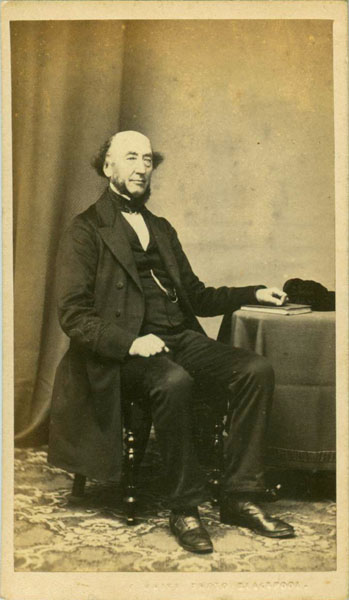
Handbill advertising the services of G. White, Daguerreotypist of Rose Hill, Chesterfield
Image © Derby County Record Office & Courtesy of Mike Spencer
At the time, I was unable to find out anything more about Mr. White. He isn't included on any other lists of Derbyshire photographers that I have seen. However, as a result of a recent discovery, and successful purchase, on eBay, I was able to identify him, and can now divulge what happened to him after his presumably brief sojourn in Chesterfield.

The carte de visite is of an unidentified, elegantly dressed elderly gentleman, seated in a studio, with his left hand resting on a book, which has in turn been placed on a table. There is another item on the table, possibly made of cloth. The studio setting is a fairly plain one, typical of the early to mid-1860s.

The card mount is completely blank on the reverse, but the photographer's details have been blind stamped at the base of the card front, as shown in the image above.
With the information that a photographer of this name was working in Blackpool within a decade of the presumed date of publication of the handbill, i.e. the mid-1850s, I was able to undertake a search of the census records. After a few dead ends, I found him in all four censuses from 1841 until 1871. In none of these was he described as a photographer, but I am confident it is the right person as he is shown variously as an artist or engraver, and many early photographers came to that profession through being artists.
George White was born around 1810, in either Chesterfield or Winster (he never was quite sure, according to census records). He married Ann Melbourne (dau of Belper nail manufacturer, William Melbourne) at North Wingfield in September 1834, and by the census of June 1841, they were living at a house in Chapel Avenue, Poulton le Fylde, Bispham, Lancashire. George was working as an artist, and a James White, aged 15 - possibly a nephew - is listed as an artist's apprentice. According to Bernard & Pauline Heathcote (A Faithful Likeness, publ. 2002, ISBN 0-9541934-0-7, courtesy of Ian Leith), who trawled contemporary newspapers between 1841 and 1855 for advertisements, George started work as a profile artist in 1834, either becoming a daguerreotype photographer or employing one by 1849. He also operated briefly at Preston in 1850.
Within the next few years they moved to Layton-with-Warbreck, near Blackpool, where their only son Frederick George was born in 1850. The census of April the following year shows Ann living at 1 Queen's Terrace, Layton with Warbreck, Blackpool, with their son and a nurse, but George was lodging in the parish of Church, west of Accrington. He now described himself as an engraver.
After the expiry of Beard's daguerreotype patent in August 1853 and the development of Archer's "patent free" wet collodion process, when there was a great expansion of photographic activity in England, White possibly took up the photographic business as a sideline to his art. Initially at least, he is likely to have operated mainly in the summer months, and visited areas where there were not photographers already well established. Oliver Sarony (from Scarborough) and Horatio Harrop (of Manchester) were early visiting photographers to Chesterfield, in May 1852 and 1854 respectively, while Henry Morton opened the town's first permanent studio in July 1854. Others known to have worked there in the 1850s included Andrew & James McMunn (1856), Henry Slack (October 1856), John Stringfellow and George Edgar (1858) and Hugh Boughen (1859). [Source: Professional Photographers in Derbyshire 1843-1914, by Keith I.P. Adamson, publ. Sep 1997 as Supplement No. 118 to The PhotoHistorian, by The Royal Photographic Society Historical Group, ISSN 0957-0209] No advertisements have been found for George White in Chesterfield newspapers, but it seems likely that he visited that town, albeit briefly, in the mid-1850s.
By 1861, George was back with his wife and son in the house at Queen's Terrace, and working as an "artist" once more. The carte de visite shown above is probably from the early to mid-1860s, but doesn't include an address, so it is not clear whether he had permanent premises by that time. Gillian Jones (in Lancashire Professional Photographers 1840-1940, publ. 2004 by PhotoResearch, ISBN 0-952311-5-6, courtesy of Michael Pritchard) lists him at 1 Queen's Terrace, Adelaide Street, Blackpool from 1849 to 1869, and then at 33 Adelaide Street, Blackpool in 1869. It is possible these are actually the same location.
It appears that George White retired around 1869; that is certainly how he described himself to the 1871 Census enumerator. George died in 1880, and census night in the subsequent year found his widow Ann living with their married son, still in Adelaide Street. Frederick George White, now married, stated his profession to be, "Income from houses, &c" and Ann is shown as an annuitant. Either George had done well from his art/photographic business or, more likely, Frederick had inherited property from his maternal grandfather.








No comments:
Post a Comment